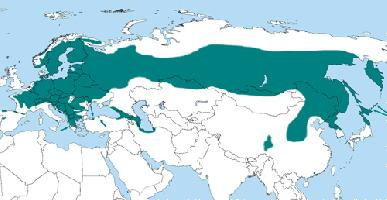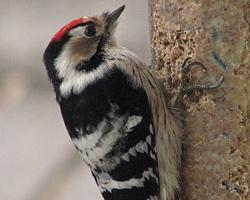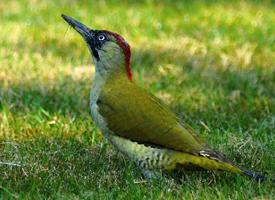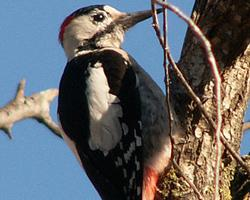
Greutăți și măsuri
| Lungime | de la 45 la 50 cm |
|---|---|
| Greutate | de la 250 la 320 g |
| Lungimea anvergurii aripilor | 76 cm |
Descrierea animalului
The Black Woodpecker (Dryocopus martius) is a captivating bird species belonging to the woodpecker family Picidae. This striking bird is the largest of the Old World woodpeckers and is notable for its predominantly jet-black plumage, which is complemented by vivid contrasting colors in specific areas, depending on the sex. Males boast a distinctive red crown, while females have a black crown with only a small red patch or none at all. Both sexes have a striking white iris, which adds to their intense gaze, and a long, chisel-like beak that is an effective tool for excavating trees in search of food or creating nesting sites.With a body length ranging from 45 to 55 cm (approximately 18 to 22 inches) and a wingspan that can reach up to 70 cm (about 28 inches), the Black Woodpecker is an impressive sight. Its size and coloration make it unmistakable in its native habitats, which stretch across the broadleaf and mixed forests of the Palearctic, from the Iberian Peninsula and Great Britain across Europe and Asia to the Pacific coast of Russia. This bird prefers mature forest areas with a good supply of large trees, including deciduous varieties like oaks and beeches, as well as coniferous trees in more northerly regions.
The Black Woodpecker is known for its powerful, resonant drumming on tree trunks, a sound that can carry over long distances in the forest and is used both to establish territory and to communicate with mates. Its diet is primarily composed of insects and their larvae, with a particular fondness for ants and their nests. It uses its strong beak to dig into decaying wood to find its prey, and its long, sticky tongue, which can be extended far beyond the beak, is adept at extracting insects from their hiding places.
Breeding season for the Black Woodpecker begins in early spring, when pairs engage in elaborate courtship displays, including mutual tapping on tree trunks and a series of calls and responses. The birds are monogamous, with pairs staying together for the breeding season and often reuniting in subsequent years. They nest in large cavities that they excavate in tree trunks, laying a clutch of 3 to 5 white eggs. Both parents share in the incubation duties and later in feeding the altricial (helpless) chicks until they are ready to fledge.
The Black Woodpecker plays a vital ecological role in its habitat. The cavities it creates in trees not only serve as nesting sites for its own species but are also used by a variety of other birds and small mammals, thus contributing to the biodiversity of the forest. Despite facing threats from habitat loss due to deforestation and logging, the Black Woodpecker is currently classified as Least Concern by the International Union for Conservation of Nature (IUCN), thanks to its wide distribution and relatively stable population numbers.
In summary, the Black Woodpecker is a remarkable bird with a striking appearance, fascinating behaviors, and an important role in its ecosystem. Its presence signifies the health of the forest ecosystems it inhabits, making it a species of interest not only to birdwatchers and naturalists but also to those concerned with the conservation of our natural world.
Harta răspândirii

Animale similare
Fotografii noi cu animale
Top 10 animale
- Dolphin gull (Leucophaeus scoresbii)
- Diana monkey (Cercopithecus diana)
- Moustached guenon (Cercopithecus cephus)
- Galápagos tortoise (Geochelone nigra complex)
- Japanese macaque (Macaca fuscata)
- Stone loach (Barbatula barbatula)
- Greek tortoise (Testudo graeca)
- Russian tortoise (Testudo horsfieldii)
- Common flying dragon (Draco volans)
- Galápagos penguin (Spheniscus mendiculus)


